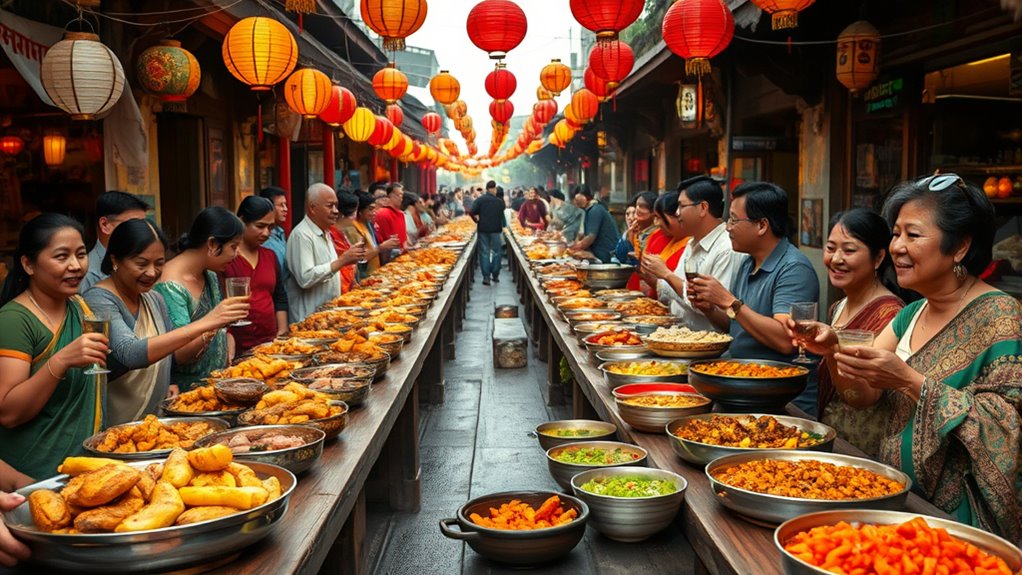Food plays a essential role in festivals worldwide, serving as a symbol of cultural identity, values, and history. When you celebrate, you share traditional dishes like dumplings, panettone, or sweets that connect communities and generations. These foods turn eating into meaningful acts of togetherness, storytelling, and pride. By exploring how different cultures honor their heritage through special meals, you’ll discover how food unites us in joyful celebrations across the globe.
Key Takeaways
- Festival foods often symbolize cultural values, hopes, and historical stories, serving as meaningful symbols beyond just nourishment.
- Traditional celebratory dishes vary worldwide, such as dumplings in Chinese New Year and panettone at Italian Christmas.
- Shared meals and communal cooking strengthen community bonds and reinforce cultural identity during festivals.
- Foods like sugar skull candies in Mexico or ladoo in India carry spiritual and legendary significance in celebrations.
- Culinary customs in festivals reflect diverse influences and environmental conditions, highlighting cultural diversity globally.

Food and festivals are deeply intertwined traditions that celebrate culture, community, and history. When you participate in these events, you quickly realize that meals are more than just sustenance—they’re a way to connect with others, honor heritage, and express identity.
Across the globe, each festival brings its own unique culinary customs, creating a rich tapestry of flavors that tell stories passed down through generations. Whether it’s a colorful street fair, a religious celebration, or a national holiday, food serves as the heart of the festivities, inviting everyone to partake in shared joy and tradition.
Every festival showcases unique culinary traditions, weaving a flavorful story passed through generations that unites communities worldwide.
In many cultures, specific dishes are central to festival celebrations. For example, during Chinese New Year, you might enjoy dumplings symbolizing wealth and prosperity, while in Italy, Christmas wouldn’t be complete without a hearty feast featuring lasagna, panettone, and roasted meats. These meals aren’t just about taste—they carry symbolism and meaning, reminding you of values, hopes, and the community’s collective history.
The act of preparing, sharing, and eating these foods creates bonds, reinforcing a sense of belonging and continuity through time.
Festivals often involve communal cooking and shared meals, which foster a sense of togetherness. Imagine yourself participating in a lively street festival where food vendors line the streets, offering fragrant, colorful dishes from local recipes.
You might join neighbors in preparing traditional dishes or gather around long tables laden with regional specialties. These communal eating experiences aren’t just about nourishment; they’re celebrations of identity and pride.
They give you the chance to learn about different culinary traditions and to appreciate how food can bring people closer, breaking down barriers and building bonds through shared enjoyment.
The diversity of celebratory foods worldwide reflects the variety of cultural influences and environmental conditions. In India, festivals like Diwali feature sweets such as ladoo and barfi, which are meticulously prepared and shared among families.
In Mexico, Día de los Muertos is marked by sugar skull candies and pan de muerto, symbolizing remembrance and life. In each case, the preparation and consumption of specific foods are integral to the ritual, turning eating into a meaningful act that embodies cultural values and history.
Many of these foods are also influenced by the rise of clean beauty trends, emphasizing natural ingredients and traditional recipes, which further enrich the cultural significance of festival foods.
These dishes often carry stories, legends, or spiritual significance, making every bite a connection to the past and a hope for the future.
Ultimately, food and festivals are inseparable. They transform simple ingredients into powerful symbols of community, tradition, and celebration.
When you partake in these culinary festivities, you’re not just tasting delicious dishes—you’re immersing yourself in a culture’s story, its history, and its collective identity.
The next time you attend a festival, pay attention to the food; it’s a vibrant thread woven into the fabric of cultural expression, inviting you to join in a global celebration of life.
Frequently Asked Questions
How Do Dietary Restrictions Influence Festive Meal Traditions Worldwide?
You might notice that dietary restrictions shape festive meal traditions in many cultures. When you or others have allergies, religious rules, or health concerns, you adapt recipes or select specific foods to respect those needs.
This influence encourages creativity and inclusivity, ensuring everyone can join in the celebration. As a result, traditional dishes evolve, reflecting diverse dietary practices while maintaining the spirit of shared joy and cultural identity during festivities.
What Are Some Unique Regional Ingredients Used in Celebratory Dishes?
When exploring celebratory dishes, you’ll notice that regional ingredients make each meal special.
In Italy, saffron adds vibrant color and aroma to risottos.
In Japan, yuzu provides a bright citrus flavor to festive dishes.
Mexico uses mole sauce with chocolate and chili for rich celebrations.
In India, saffron and turmeric infuse dishes with color and warmth.
These unique ingredients highlight local flavors and cultural traditions, making each celebration memorable.
How Have Modern Dietary Trends Impacted Traditional Festival Foods?
You might notice that modern dietary trends, like veganism and gluten-free diets, influence traditional festival foods. As a result, you see more plant-based, allergen-free options replacing classic ingredients, making celebrations more inclusive.
Chefs adapt recipes to meet these needs, blending tradition with health-conscious choices. This shift allows everyone to enjoy festive meals without compromising their dietary preferences, creating a more diverse and accessible culinary experience during festivals.
Are There Specific Etiquette Rules Associated With Festival Meals in Different Cultures?
Imagine you’re at a Chinese New Year dinner, and you notice the importance of passing dishes with both hands. In many cultures, specific etiquette rules guide festival meals, like waiting for the host to start eating or avoiding sticking chopsticks upright in rice, which symbolizes death.
These customs show respect and unity. Paying attention to these rules helps you connect better and honor the traditions of each celebration.
How Do Food Festivals Promote Local Economies and Cultural Heritage?
You see, food festivals boost local economies by attracting visitors who spend on food, crafts, and accommodations. They also showcase unique cultural traditions, helping preserve heritage and attract tourism.
When you participate, you support local vendors and farmers, ensuring their traditions and products thrive. These festivals create a lively atmosphere that highlights a community’s identity, encouraging pride and ongoing cultural preservation while providing economic benefits for everyone involved.
Conclusion
As you explore the world’s festivals, you’ll see how food brings people together in celebration. Did you know that over 70% of global festivals feature special dishes that symbolize unity and tradition? Whether it’s sharing a meal during Chinese New Year or enjoying festive treats in Italy, food creates lasting memories and connections. So, next time you celebrate, remember that your meal isn’t just sustenance—it’s a universal language that unites us all.









